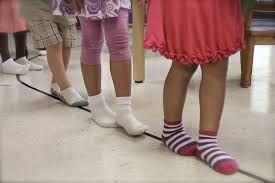ACE Montessori Enriched Home Preschool, Cobourg
---- Where Independence and Character are Nurtured----
Care of Plants:
This activity promotes control of movement and learning how to care for plants.
(Practical Life Album 54)
The child is shown how to remove dead leaves or flowers, how to clean each leaf and then to water the plant.
A child of three and a half and upwards can be introduced to this activity.
This activity falls under Care of the Indoor Environment.


Raking Leaves:
This activity promotes hand-eye coordination, care of the outdoor environment and learning how to rake properly. ( Practical Life Album 58)
The child is shown how to carefully rake all leaves in a circular pile and then to place the leaves in a basket or bag.
A child of two and a half can be introduced to this lesson.
This activity falls under Care of the Outdoor Environment

Blowing the Nose Using a Tissue:
This activity promotes personal independence, personal hygiene, and how to keep a clean nose. ( Practical Life Album 61)
A child of three years old and upwards is introduced to this activity.
This activity falls under Care of the Person.


Practical Life
Quote
In Practical Life, the children see materials and objects that they recognize from their home and start to understand how to take care of those objects, such as a plant or how to use a spoon correctly without spilling. Major focuses in Practical Life are hand-eye coordination, grace and courtesy and order. Practical Life is the first curriculum that children are exposed to in a Montessori environment as it provides a direct link between home and school life.
Practical Life activities fall under six categories: Preliminary Exercises, Care of the Indoor and Outdoor Environment, Care of the Person, Grace and Courtesy and Control of Movement.
In Grace and Courtesy, children learn when and how to extend greetings, say 'please','thank you' and 'excuse me'.
Each activity leads to the next and provides an increasing challenge as the child moves through this curriculum area.

Examples of Practical Life Activities& their Importance in Child Development
Opening and Closing of Bottles and Boxes:
This work is intended to help develop wrist and finger muscle control, hand-eye coordination and to teach children how to open and close bottles and boxes. ( Practical Life Album 29)
A child of two and a half and upwards can be introduced to this concept. It is a useful link for home, as children will become more independent opening and closing food items from their snack cupboard.
This is a Preliminary Exercise.


Walking on the Line:
This activity promotes balance and perfecting the skill of walking. ( Practical Life Album 77)
Children are shown how to transition from walking freely to walking heel to toe on an ellipse in the classroom. Extensions are offered as each skill is mastered such as, walking with a flag, a bell or a cup of water, all of which require greater control of movement.
This activity falls under Control of Movement.


Relevant Current Scientific Research & how it validates Dr. Montessori's principles
The New York Times online edition, originally posted on 03/31/2017, entitled 'Why Kids Shouldn't Sit Still in Class', explores why movement is vital to brain development. Dr. Montessori's philosophy on movement is that there should be freedom of movement, within limits, in the Prepared Environment and that children learn better when they are active and hands-on with materials and that the classroom is organized in a way to promote a free flow of movement. In contrast, in a traditional classroom, free movement is discouraged and children are praised for sitting still for longer periods of time.
The articles explores how the introduction of movement breaks, during the school day, is becoming a popular trend. In Montessori classrooms, movement is encouraged. Children have the ability to choose their learning for the day and might choose yoga or perhaps will choose to complete more auditory or tactile activities that promote a refinement of the senses.
Children learn differently and Montessori classrooms meet the different learning styles. A child who requires more fine motor support is able to take out a material from a range of materials that promote fine motor movements.
In particular, movement is integral to Practical Life where children are taking pieces of work from the shelf to a table, filling up a water jug at the sink and then walking back to the table, pushing in their chairs each time they stand up. In addition to the gross motor development of moving about the classroom, there is a refinement of fine motor skills through a repetition of movement. For example, washing windows in a counter clockwise motion.
As cited in the New York Times article above, John Ratey, an associate professor of psychiatry at Harvard Medical School and the author of “Spark: The Revolutionary New Science of Exercise and the Brain,” said: “Movement activates all the brain cells kids are using to learn, it wakes up the brain. Plus, it makes kids want to come to school more — it’s fun to do these activities.”